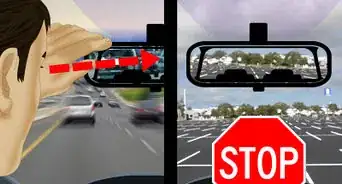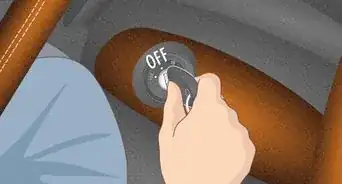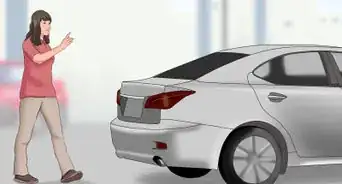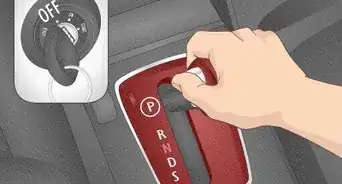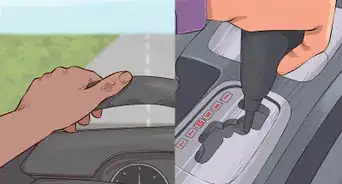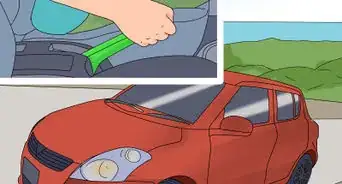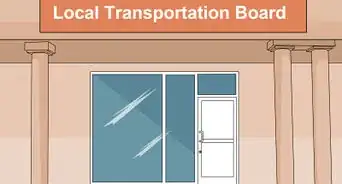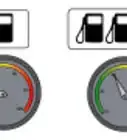This article was co-authored by Simon Miyerov. Simon Miyerov is the President and Driving Instructor for Drive Rite Academy, a driving academy based out of New York City. Simon has over 8 years of driving instruction experience. His mission is to ensure the safety of everyday drivers and continue to make New York a safer and efficient driving environment.
wikiHow marks an article as reader-approved once it receives enough positive feedback. In this case, 87% of readers who voted found the article helpful, earning it our reader-approved status.
This article has been viewed 683,777 times.
When first learning to drive, you were most likely taught to adjust a car’s mirrors before driving it for the first time. You were then likely warned about the blind spots on each side, which you should always check before changing lanes or turning. However, it is possible to adjust a car’s mirrors in a way that eliminates these blind spots, meaning that only a quick glance becomes necessary before changing lanes. You’ll need to start by adjusting the side and center rear view mirrors, then confirm they overlap properly.
Steps
Adjusting the Side Mirrors
-
1Lean your head over to the left and adjust the mirror. You should be leaning so that your head almost touches the driver's window. If your mirror is adjusted in the traditional fashion, the side of your car should almost take up the whole mirror. Correct this by adjusting the mirror until you can just see the rear quarterpanel (the rear end of the car).[1] If you’ve adjusted the mirror correctly, the rear of your car should occupy less than a third of the mirror.
-
2Lean your head to the right and adjust your side mirror. Your head should be as close to the center as you can without having to leave your seat. From there, position the right side mirror so you can just see the rear quarterpanel of the passenger side in the mirror.[2] Again, ensure the quarterpanel takes up less than a third of the mirror’s view.Advertisement
-
3Return to your usual position in the driver’s seat and adjust the center rearview mirror. Place this mirror to see as much of your rear window as you can. You want to see directly out of the rear of your vehicle; don’t try tilting the mirror to get a better view of traffic on either side.[3] The center mirror should compensate for what the side mirrors can’t see, not compensate for badly adjusted side mirrors.
Confirming the Elimination of the Blind Spots
-
1Check the adjustment of your mirrors from a normal, seated driving position. You shouldn’t be able to see your car at all in either side mirror, giving you a much wider view.[4] If you can still see the side of your car in either mirror, try the above steps again. You’ll likely need to adjust the mirrors so they point further outward.
-
2Confirm the additional view provided by your side mirrors after proper adjustment. Your mirrors should now cover more of the lanes right next to your car. Not only can you keep track of cars behind you and to the side, but you can follow them visually as they approach, going a long way to eliminating your car’s blind spots.[5] While you’ll still want to perform a quick shoulder check for added safety when changing lanes, you’ll now have a better view of vehicles and objects to the sides.
-
3Check to ensure objects to the rear transition to the side mirrors as they pass you. Pay particular attention to cars passing you. As they approach, you should first see them in the center rear view mirror. Then, as they pass you, they’ll move laterally through your center rear view mirror until they appear in the corresponding side mirror. This transition should be smooth; the vehicle should be reflected by your side mirror as soon as it leaves the center mirror. This confirms the elimination of your car’s blind spots.
- If there is a pause between the vehicle leaving the center mirror and appearing on your side mirror, you’ll need to re-adjust your mirrors as there’s still a blind spot left.
Expert Q&A
-
QuestionHow do I get rid of all my blind spots?
 Simon MiyerovSimon Miyerov is the President and Driving Instructor for Drive Rite Academy, a driving academy based out of New York City. Simon has over 8 years of driving instruction experience. His mission is to ensure the safety of everyday drivers and continue to make New York a safer and efficient driving environment.
Simon MiyerovSimon Miyerov is the President and Driving Instructor for Drive Rite Academy, a driving academy based out of New York City. Simon has over 8 years of driving instruction experience. His mission is to ensure the safety of everyday drivers and continue to make New York a safer and efficient driving environment.
Driving Instructor Every vehicle has blind spots, and different types of vehicles have different types of blind spots. You may be able to adjust your mirrors in a way where you minimize the size of your blind spots, but you aren't going to be able to get rid of them completely.
Every vehicle has blind spots, and different types of vehicles have different types of blind spots. You may be able to adjust your mirrors in a way where you minimize the size of your blind spots, but you aren't going to be able to get rid of them completely. -
QuestionWhat if the view isn't the same in both side mirrors?
 Community AnswerThis usually means one of the mirrors was not adjusted properly. When seated in a normal driving position, you shouldn't see your car at all in their side mirror. If only one side mirror shows your car, lean towards that side mirror and correct its alignment until you barely see the side of your car.
Community AnswerThis usually means one of the mirrors was not adjusted properly. When seated in a normal driving position, you shouldn't see your car at all in their side mirror. If only one side mirror shows your car, lean towards that side mirror and correct its alignment until you barely see the side of your car. -
QuestionIs there any small mirror I can buy for my blind spot?
 Community AnswerBlindspot mirrors can be purchased online or perhaps motor factors/car shops. Between about £2 and £10.
Community AnswerBlindspot mirrors can be purchased online or perhaps motor factors/car shops. Between about £2 and £10.
Warnings
- Don't adjust mirrors while driving.⧼thumbs_response⧽
- Always look over your shoulders before changing lanes! While this mirror method eliminates blind spots for most vehicles, it is possible that motorcycles, bicycles and pedestrians won’t be as visible.⧼thumbs_response⧽
References
- ↑ http://pages.cs.wisc.edu/~gdguo/driving/BlindSpot.htm
- ↑ http://pages.cs.wisc.edu/~gdguo/driving/BlindSpot.htm
- ↑ http://pages.cs.wisc.edu/~gdguo/driving/BlindSpot.htm
- ↑ http://pages.cs.wisc.edu/~gdguo/driving/BlindSpot.htm
- ↑ http://www.caranddriver.com/features/how-to-adjust-your-mirrors-to-avoid-blind-spots
About This Article
To set your rear-view mirrors in order to eliminate blind spots, start by leaning your head to the left so that your head is almost touching the window. Then, adjust the driver’s side window so that you can see just the rear end of the car in the mirror. Next, lean to your right and adjust the passenger-side mirror so that you can see just the rear end of the car on that side, as well. Finally, return to your usual position and move the center mirror so that you can see directly out your rear window, and avoid tilting the mirror to get a better view of the traffic on either side. To learn more, like how to check the adjustment of your side mirrors from a normal, seated position, read on!








